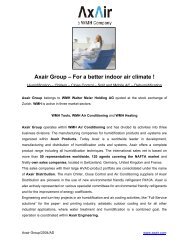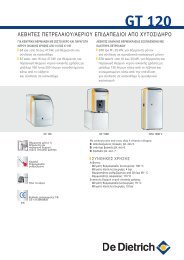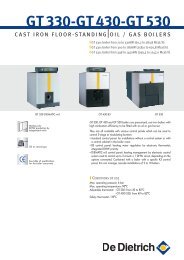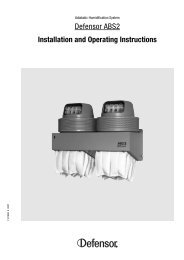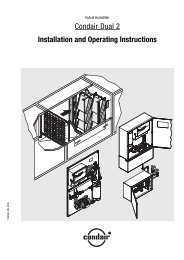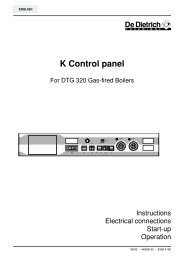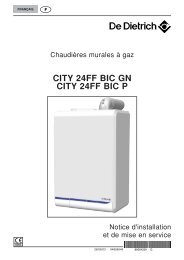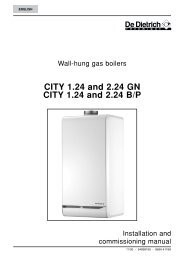GT/GTM/GTG 300/II GT/GTM/GTG/GTI 300 K/II GT/GTM 300 ...
GT/GTM/GTG 300/II GT/GTM/GTG/GTI 300 K/II GT/GTM 300 ...
GT/GTM/GTG 300/II GT/GTM/GTG/GTI 300 K/II GT/GTM 300 ...
Create successful ePaper yourself
Turn your PDF publications into a flip-book with our unique Google optimized e-Paper software.
4. HYDRAULIC CONNECTIONS<br />
4.1 Important recommendations for connecting the heating circuit to the boiler and<br />
to the drinking water system<br />
The installation shall be made in accordance with<br />
applicable regulations and codes of practice.<br />
The expansion tank shall be connected to the boiler<br />
without any valve or stop valve between the boiler and<br />
the expansion tank.<br />
Similarly, the safety valve shall be connected<br />
to the boiler without any valve or stop valve<br />
between the boiler and the safety valve.<br />
Example of installation :<br />
The example below does not cover all the possible cases of<br />
use. It is only aimed at drawing attention to the basic rules<br />
which must be complied with. In all events, comply with applicable<br />
codes of practice and national or local regulations.<br />
Example of a <strong>GT</strong> <strong>300</strong>/<strong>II</strong> boiler with domestic hot water<br />
production via one or more independent calorifiers.<br />
11<br />
27<br />
3<br />
10<br />
4 5<br />
7 26 25 7<br />
8<br />
7<br />
7<br />
7<br />
13<br />
1. Heating outlet<br />
2. Heating return<br />
3. 3 bar safety valve and pressure gauge<br />
4. Flow switch (if necessary)<br />
5. Air separator<br />
6. Automatic venting valve<br />
7. Valve<br />
8. Recycling pump (recommended for <strong>GT</strong> 304/<strong>II</strong>,<br />
compulsory for <strong>GT</strong> 305/<strong>II</strong> to 309/<strong>II</strong>)<br />
9. Expansion tank<br />
10. Draining valve<br />
11. Sludge removal valve<br />
12. Mixing valve<br />
13. Non return valve<br />
14. Heating pump<br />
15. Low-water safety pressure-sensitive switch<br />
9<br />
7<br />
6<br />
7<br />
22<br />
10<br />
7<br />
6 7<br />
9<br />
21<br />
The heating system shall be designed and installed in<br />
a way as to prevent the water from the heating circuit<br />
and any substances added to it from flowing back into<br />
the drinking water circuit located before it. The installation<br />
shall not be directly connected to the drinking<br />
water system.<br />
12 7<br />
1<br />
17<br />
7<br />
24<br />
13<br />
23<br />
13<br />
7<br />
19<br />
7<br />
14<br />
20<br />
15<br />
10<br />
16<br />
7<br />
2<br />
Heating<br />
circuit<br />
8219N008A<br />
18<br />
16. Sludge decanting pot (particularly recommended for<br />
older heating systems)<br />
17. Independent calorifier<br />
18. Sealed safety unit calibrated to 7 bar with indicator<br />
type discharger<br />
19. Pressure reducer (if mains pressure > 5.5 bar)<br />
20. Domestic cold water inlet<br />
21. Domestic hot water outlet<br />
22. Load pump<br />
23. Domestic hot water circulation pump (optional)<br />
24. DHW circulation loop return<br />
25. Water meter (if any)<br />
26. Water treatment if TH > 25°<br />
27. Heating circuit filling (with disconnector if required<br />
under applicable regulations).



